
Section 1: Understanding Google Sitelinks
1.1 What Are Google Sitelinks?
Google sitelinks are additional links that appear beneath the main search result on Google’s search engine results pages (SERPs). They provide users with quick access to internal pages of a website directly from the search results. Sitelinks are typically displayed for brand searches or when Google determines that the website is highly relevant to the user’s query. These sitelinks are designed to enhance the user experience by offering more specific and targeted navigation options.
1.2 The Significance of Google Sitelinks
Google sitelinks offer several significant benefits for both website owners and users. Firstly, they improve click-through rates (CTR) by providing users with direct access to relevant internal pages. Instead of navigating through the website’s hierarchy, users can simply click on the sitelinks to find the information they need. This streamlined navigation increases user satisfaction and encourages more engagement with the website.
Secondly, Google sitelinks contribute to building trust and credibility. When sitelinks appear in the search results, it signals to users that the website is well-structured and authoritative. This increased visibility and prominence can instill confidence in users, leading to a higher likelihood of them clicking on the website’s link.
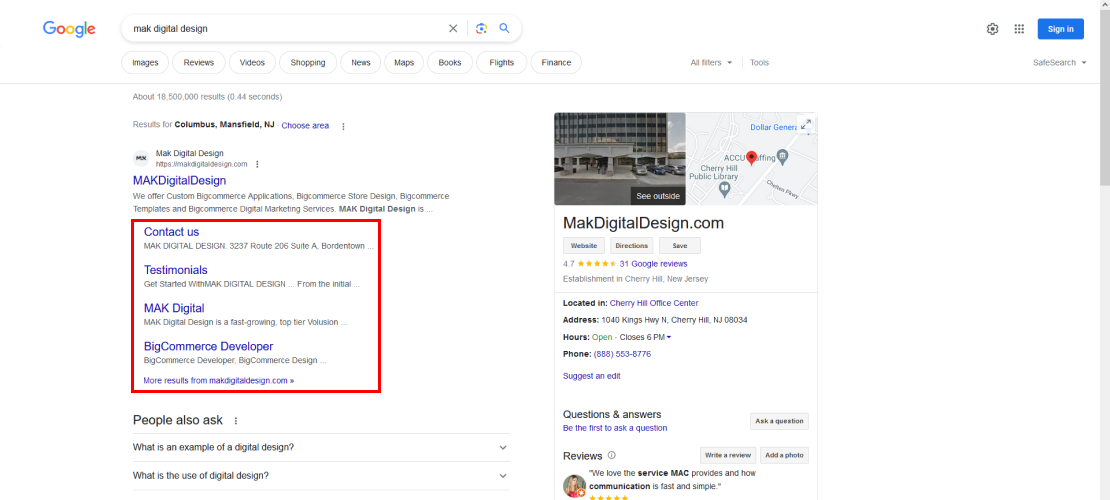
Thirdly, sitelinks help enhance brand awareness and visibility. By displaying additional links to specific internal pages, sitelinks allow users to gain a deeper understanding of the brand and its offerings without even visiting the website. This exposure helps in creating a strong brand impression and increasing recognition among users.
Lastly, sitelinks facilitate user exploration of deep website content. While most visitors tend to stick to the homepage or browse a few key pages, sitelinks provide an opportunity to showcase specific pages such as popular blog posts, best-selling products, or informative guides. By featuring these important pages as sitelinks, website owners can guide users to relevant and valuable content that they might not have discovered otherwise.
Section 2: Strategies to Maximize Google Sitelinks
2.1 Establishing a Strong Foundation
2.1.1 Developing a Distinctive Brand Identity
To maximize the chances of obtaining sitelinks, it is crucial to establish a distinctive brand identity. A unique brand name sets you apart from competitors and improves the chances of ranking higher in brand searches. When users search for your brand specifically, having a distinct name makes it easier for Google to understand the user’s intent and display sitelinks accordingly. Choosing a memorable and relevant brand name that reflects your business’s values and offerings will contribute to a stronger brand identity.
2.1.2 Optimizing Website Structure and Navigation
An optimized website structure and intuitive navigation are fundamental for sitelinks. A clear and logical hierarchy ensures that search engines and users can easily navigate through your website. The homepage should serve as the central hub, with other pages branching off from it. Organize your pages into relevant categories and subcategories, using clear headings and labels. Additionally, ensure that standard webpages such as About, Contact, and Products/Services are easily accessible and optimized for search engines.
For example, look at the screenshot below showcasing the site links of MAKDigital. As seen in the image, MAKDigital has strategically optimized our sitelinks to prominently display our Contact Us, Testimonials, About Us, and a Services page, making it convenient for users to navigate to these key sections of our website!
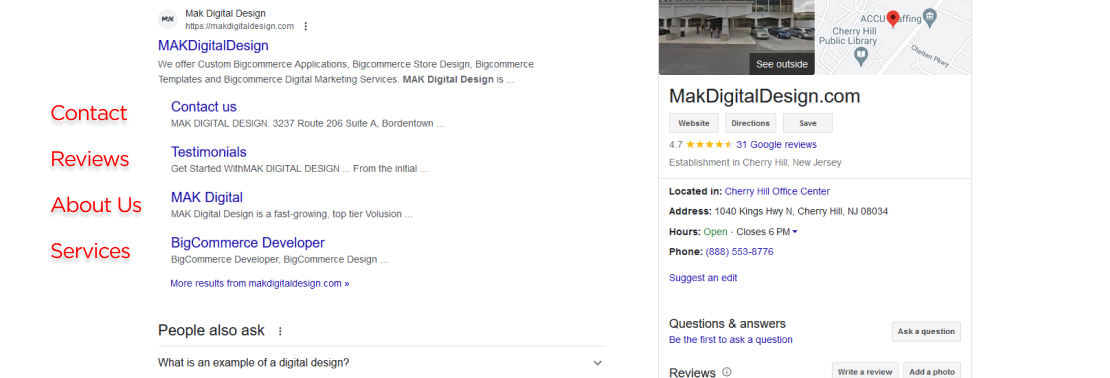
The careful optimization of sitelinks enhances the user experience and increases the likelihood of visitors exploring specific pages that are relevant to their needs. By following similar best practices and ensuring that your standard webpages are well-structured and optimized, you can improve the chances of your sitelinks being prominently featured, thereby driving more targeted traffic to your website.
2.2 Leveraging Structured Data Markup
2.2.1 Understanding Schema Markup for Sitelinks
Schema markup, also known as structured data markup, is a code that provides search engines with additional context about your website’s content. It helps search engines understand the meaning and relationships between different elements on your site. While schema markup does not guarantee sitelinks, implementing it can increase the likelihood of Google considering specific pages for sitelinks. By using schema markup, you can specify relevant pages for sitelinks, breadcrumbs, or a sitelinks search box, giving search engines more information to determine the most appropriate sitelinks for your website.
2.2.2 Implementing Schema Markup for Sitelinks Optimization
To optimize sitelinks with schema markup, identify the pages you want to be considered for sitelinks. For example, you may want to highlight important product pages, service categories, or informational resources. Implement schema markup by adding the appropriate structured data code to these specific pages. Specify the necessary properties and attributes to provide search engines with a clear understanding of the page’s content and its relevance to sitelinks.
2.3 Internal Linking Strategies
2.3.1 Harnessing the Power of Internal Links
Internal linking plays a crucial role in improving sitelinks visibility and website navigation. By strategically linking relevant pages within your website, you signal their importance to search engines. Internal links help search engine crawlers discover and index your content effectively, while also providing users with a seamless navigation experience. The more internal links point to a particular page, the more likely it is to be considered for sitelinks.
2.3.2 Best Practices for Internal Linking to Optimize Sitelinks
To optimize sitelinks through internal linking, identify key pages that you want to promote and make them easily accessible throughout your website. Incorporate contextual anchor texts that accurately describe the linked page’s content and purpose. Ensure that the internal links are placed naturally within the content and provide value to users. By strategically interlinking your important pages, you increase their visibility and improve the chances of them being selected as sitelinks.
2.4 Crafting Compelling Page Titles
2.4.1 The Role of Page Titles in Sitelinks Generation
Page titles are vital for sitelinks as they directly influence how sitelinks are generated. Google generates sitelinks based on the page titles that best match the user’s search query. Clear and relevant page titles not only improve sitelinks visibility but also contribute to a better user experience. A concise and descriptive title accurately conveys what the page offers, enabling users to understand its relevance and encouraging them to click through.
2.4.2 Optimizing Page Titles for Sitelinks Recognition
To optimize page titles for sitelinks, ensure that each page has a unique and descriptive title that aligns with its content. Incorporate relevant keywords that users are likely to search for when looking for your products or services. Avoid generic or misleading titles that may confuse search engines and users. By aligning page titles with the content and using appropriate keywords, you increase the chances of Google recognizing and displaying sitelinks for those pages.
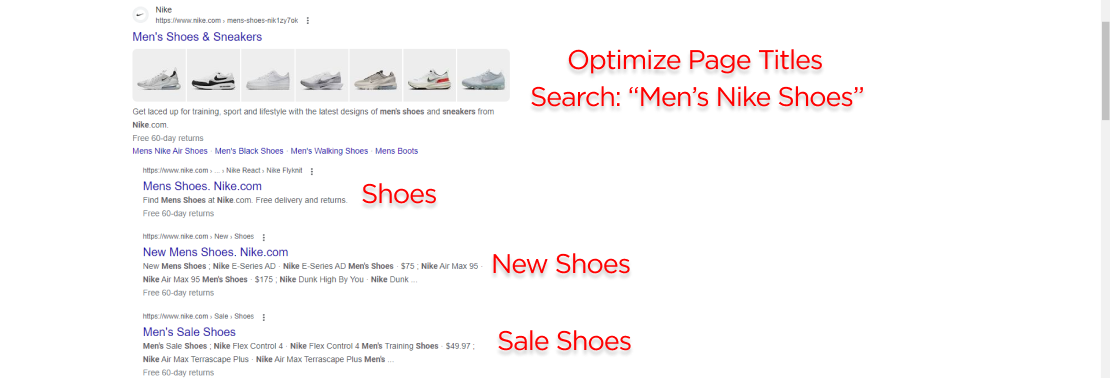
2.5 Building Brand Awareness for Sitelinks
2.5.1 The Significance of Brand Awareness in Sitelinks
Brand awareness plays a crucial role in sitelinks recognition. When users are familiar with your brand, they are more likely to search for it specifically, leading to increased branded searches. Google recognizes the significance of brand searches and considers sitelinks for websites with a strong brand presence. By building brand awareness, you enhance your chances of obtaining sitelinks and maximizing their visibility.
2.5.2 Strategies to Enhance Brand Awareness for Sitelinks
To enhance brand awareness, implement various marketing strategies that increase your online visibility and reputation. Guest blogging on popular industry sites can expose your brand to a wider audience. Engage in interviews or reach out to online news outlets for potential media coverage. Encourage positive reviews and testimonials from satisfied customers. Participate in online community discussions and establish your brand as an authority in your niche. By actively promoting your brand, you increase its recognition and improve the likelihood of sitelinks appearing for branded searches.
2.6 Addressing Mobile Sitelinks
2.6.1 Advantages of Mobile Sitelinks
Let’s take a look at the screenshot below, showcasing the mobile site links of MAKDigital. As depicted in the image, the sitelinks occupy a significant portion of the mobile screen, pushing down competitor links below the fold. This prominent placement ensures that users do not have to scroll to see MAKDigital’s sitelinks, providing them with immediate access to essential pages like Contact Us, Testimonials, About Us, and Services. By effectively utilizing the screen real estate, MAKDigital creates a compelling visual presence and increases the likelihood of users engaging with our site links without having to navigate through other search results.
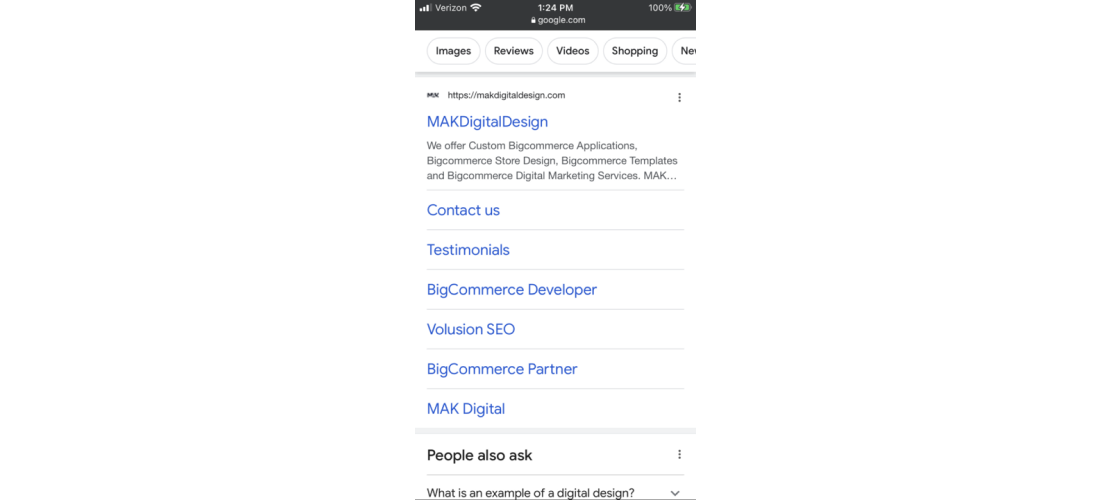
The strategic positioning of sitelinks on mobile devices offers a competitive advantage by capturing users’ attention and making it convenient for them to explore MAKDigital’s key pages. This not only enhances the user experience but also increases the chances of attracting qualified leads and conversions. By optimizing sitelinks for mobile screens and dominating the available space, businesses can effectively differentiate themselves from competitors and drive valuable mobile traffic to their website.
Section 3: Maximizing Sitelinks with AdWords Campaigns
3.1 Understanding AdWords Sitelinks
In addition to organic sitelinks, Google AdWords provides an opportunity to enhance your search ads with sitelinks. AdWords sitelinks are manually added by campaign managers and offer a similar functionality to organic sitelinks. These additional links appear as extensions to your search ads, providing users with direct access to specific pages on your website.
3.2 The Benefits of AdWords Sitelinks
Integrating sitelinks into your AdWords campaigns can significantly improve the effectiveness of your ads and drive more targeted traffic. By including sitelinks, you provide users with additional navigation options, making it easier for them to find what they’re looking for. AdWords sitelinks allow you to highlight specific products, services, promotions, or other relevant pages, increasing the visibility of your offerings and enticing users to click on your ad.
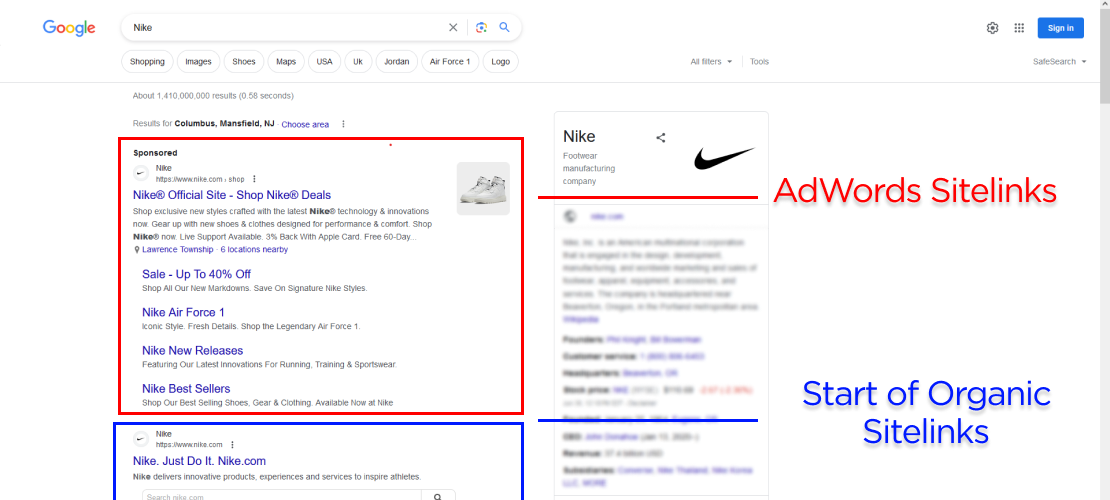
3.3 Adding Sitelinks to Your AdWords Campaign
To add sitelinks to your AdWords campaign, you need to access the campaign settings and navigate to the ad extensions section. From there, you can create sitelink extensions and specify the URLs and anchor texts for each sitelink. It’s important to align the sitelinks with the content of your ad and the user’s search intent. You can also add descriptions to provide additional context and entice users to click on the sitelinks.
3.4 Best Practices for AdWords Sitelinks
When incorporating sitelinks into your AdWords campaign, keep the following best practices in mind:
3.4.1 Relevant and Descriptive Sitelinks
Ensure that your sitelinks are relevant to the ad and provide valuable information or options for the user. Use descriptive anchor texts that accurately describe the linked page’s content. For example, if you’re running an ad for a clothing store, the sitelinks could include options such as “Shop Women’s Clothing,” “Explore Men’s Accessories,” or “View Sale Items.”
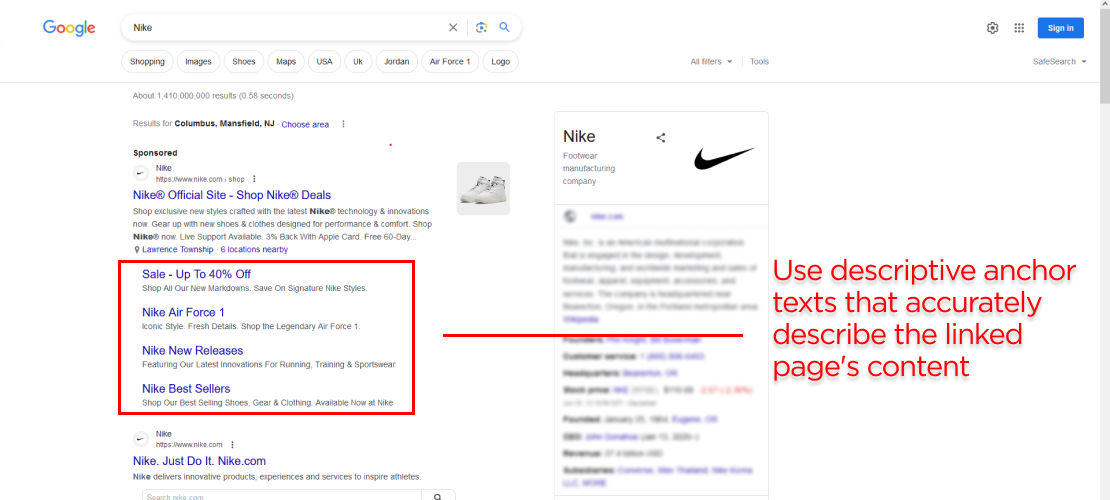
3.4.2 Consistent Landing Pages
When users click on a sitelink, they expect to land on a page directly related to the sitelink’s description. Ensure that the landing pages associated with your sitelinks align with the user’s expectations and provide a seamless experience. Directing users to relevant and specific landing pages improves their satisfaction and increases the likelihood of conversion.
3.4.3 Monitoring and Optimization
Regularly monitor the performance of your AdWords sitelinks and make data-driven optimizations. Analyze click-through rates, conversion rates, and other key metrics to identify sitelinks that resonate well with your audience and drive meaningful results. Consider experimenting with different sitelinks, descriptions, and placements to continually optimize your campaign’s performance.
Conclusion:
By understanding the significance of Google sitelinks and implementing effective strategies, website owners can maximize their chances of obtaining and optimizing sitelinks. Through a strong foundation, including distinctive brand identity and optimized website structure, combined with leveraging structured data markup, internal linking, and compelling page titles, website owners can increase their visibility and user experience. Additionally, building brand awareness further enhances the chances of sitelinks appearing for branded searches. By consistently applying these strategies and staying dedicated to SEO efforts, website owners can harness the power of Google sitelinks and drive greater organic traffic and engagement.
Mitch is an experienced eCommerce Project Manager specializing in delivering seamless online experiences and driving digital growth. With expertise in project planning, platform optimization, and team collaboration, Mitch ensures every eCommerce initiative exceeds expectations. Passionate about innovation and results, Mitch helps businesses stay ahead in the dynamic digital landscape.

